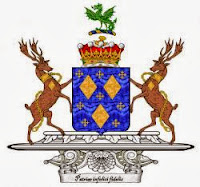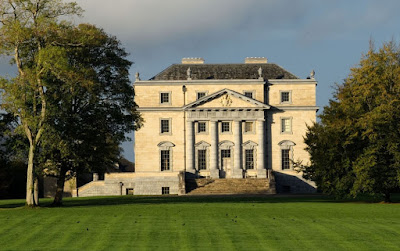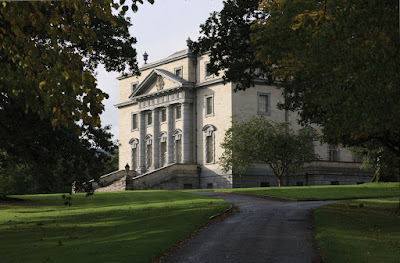THE EARLS OF COURTOWN WERE MAJOR LANDOWNERS IN COUNTY WEXFORD, WITH 14,426 ACRES
This family is said to derive its descent from Nicholas de Stockport, Baron of Stockport, one of the eight barons of the county palatine of Chester, created by Hugh Lupus, Earl of Chester, in the reign of WILLIAM THE CONQUEROR.
It is probable the family had been settled in that county before the Conquest, and certainly the estate of Salterstown, near Macclesfield, in Cheshire, belonged to the Stopfords from time immemorial.
The first of the family who settled in Ireland,
JAMES STOPFORD (1620-85), of Saltersford, Cheshire, a captain in Cromwell's army in Ireland, married firstly, Ellinor, daughter of John Morewood, of The Oaks, Yorkshire, and had issue (with a daughter),
WILLIAM, his heir, father of JAMES;James;Joseph, father of the Rt Rev James Stopford.
He wedded secondly, Mary, daughter of Sir Robert Forth, and had further issue, two daughters.
Upon the restoration of the royal family, acquiring considerable estates in that kingdom, partly by purchase, and partly by grants, he took up his abode at Tara Hill, County Meath.
Captain Stopford was succeeded by his grandson,
JAMES STOPFORD (1668-1721), MP for Wexford Borough, 1703-13, County Wexford, 1713-21, who wedded Frances, daughter and heir of Roger Jones, of Dublin, by whom he had five sons and four daughters.
He was succeeded at his decease by his eldest surviving son,
JAMES STOPFORD (1700-70), MP for County Wexford, 1721-7, Fethard, 1727-58, High Sheriff of County Wexford, 1756, who was elevated to the peerage, in 1758, in the dignity of Baron Courtown, of Wexford; and, in 1762, advanced to the dignities of Viscount Stopford and EARL OF COURTOWN.
His lordship married Elizabeth, only daughter of the Rt Rev Edward Smyth, Lord Bishop of Down and Connor, and had issue,
JAMES, his successor;His lordship was succeeded by his eldest son,
Edward, lieutenant-general in the army;
Thomas (Rt Rev), Lord Bishop of Cork and Ross;
Joseph;
Philip;
Frances; Mary; Anne; Catherine; Charlotte.
JAMES, 2nd Earl (1731-1810), KP, PC, who was created a peer of Great Britain, in 1794, as Baron Saltersford.
His lordship espoused, in 1762, Mary, daughter and co-heir of Richard Powys, of Hintlesham Hall, Suffolk, by whom he had issue,
JAMES GEORGE, his successor;His lordship was succeeded by his eldest son,
Edward (Sir), GCB;
Robert (Sir), GCB, GCMG;
Richard Bruce (Rev).
JAMES GEORGE, 3rd Earl (1765-1835), KP, who married, in 1791, Mary, eldest daughter of Henry, 3rd Duke of Buccleuch, by whom he had issue,
JAMES THOMAS, his successor;
Edward;
Henry Scott;
Montagu (Sir), KCB;
Robert;
Mary Frances; Jane; Charlotte; Caroline.
- James Thomas Stopford, 4th Earl (1794–1858);
- James George Henry Stopford, 5th Earl (1823–1914);
- James Walter Milles Stopford, 6th Earl (1853–1933);
- James Richard Neville Stopford, 7th Earl (1877–1957);
- James Montagu Burgoyne Stopford, 8th Earl (1908–75);
The heir apparent is the present holder's son James Richard Ian Montagu Stopford, styled Viscount Stopford (b 1988).
*****
THE COURTOWNS were a "Patrick Family", the 2nd and 3rd Earls having been installed as Knights of St Patrick.
The 6th Earl was the last Lord-Lieutenant of County Wexford, from 1901 until 1922.
James Patrick Montagu Burgoyne Winthrop, 9th and present Earl, was a Lord in Waiting (Government Whip), 1995-97; representative peer to the House of Lords, 1999-.
COURTOWN HOUSE, near Gorey, County Wexford, was the 18th century seat of the Earls of Courtown, overlooking the sea at Courtown Harbour.
It was significantly altered and enlarged during the 19th century, following the 1798 rebellion.
The front consisted of a U-shaped block of two storeys and a dormer attic within the high-pitched, château-style roof.
The five-bay centre had a large open porch, with a porte-cochère carried on four piers.
Courtown House was demolished in 1962, having been sold to the Irish Tourist Board in 1948.
After the 2nd World War, the income from the amount of land left in the estate was not enough to keep Courtown House going and it had to be sold.
Marlfield House, once a Dower House on the Courtown estate, dates back to the 1840s.
The Courtown family also had a seat in Cheshire, Beale Hall.
Courtown Woodland was planted with oak and ash back in 1870.
At this time it was part of a typical Victorian estate woodland where exotic conifers and redwoods from California were planted within viewing distance of Courtown House.
Oak plantations were established at some distance.
They were under-planted with shrubs to provide food for pheasants for shooting parties.
The woodland was regularly cleared and used as firewood by local tenants.
During the 1860s and 1870s the 5th Earl established a pinetum, or conifer collection, in the grounds around Courtown House.
A small number of these trees remain today in the Woodland and in property across the river.
Courtown arms courtesy of European Heraldry. First published in January, 2012.
COURTOWN HOUSE, near Gorey, County Wexford, was the 18th century seat of the Earls of Courtown, overlooking the sea at Courtown Harbour.
It was significantly altered and enlarged during the 19th century, following the 1798 rebellion.
The front consisted of a U-shaped block of two storeys and a dormer attic within the high-pitched, château-style roof.
The five-bay centre had a large open porch, with a porte-cochère carried on four piers.
Courtown House was demolished in 1962, having been sold to the Irish Tourist Board in 1948.
After the 2nd World War, the income from the amount of land left in the estate was not enough to keep Courtown House going and it had to be sold.
Marlfield House, once a Dower House on the Courtown estate, dates back to the 1840s.
The Courtown family also had a seat in Cheshire, Beale Hall.
Courtown Woodland was planted with oak and ash back in 1870.
At this time it was part of a typical Victorian estate woodland where exotic conifers and redwoods from California were planted within viewing distance of Courtown House.
Oak plantations were established at some distance.
They were under-planted with shrubs to provide food for pheasants for shooting parties.
The woodland was regularly cleared and used as firewood by local tenants.
During the 1860s and 1870s the 5th Earl established a pinetum, or conifer collection, in the grounds around Courtown House.
A small number of these trees remain today in the Woodland and in property across the river.
Courtown arms courtesy of European Heraldry. First published in January, 2012.












